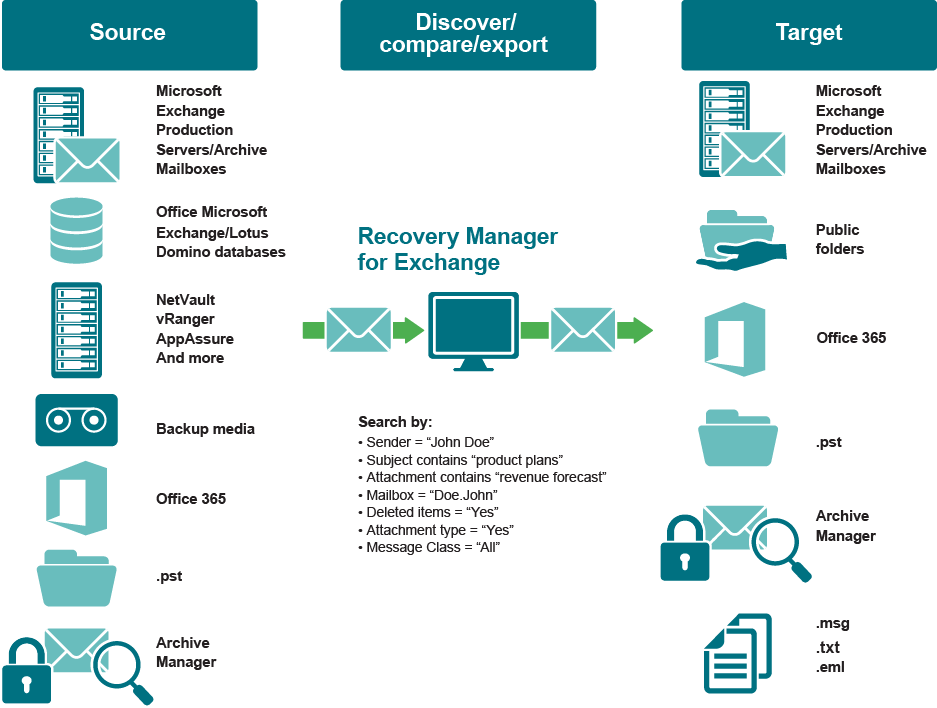Automated tasks
With large backups, cataloging and restoration can take a long time. Recovery Manager for Exchange provides the Automated Tasks feature that allows you to create, modify, schedule, run, stop, and monitor automated cataloging and restoration tasks.
An automated task holds a set of actions required to catalog a backup or restore specific items. Using automated tasks improves the Recovery Manager for Exchange productivity and saves system resources in situations when you need to catalog extremely large backups or restore significant amounts of data.
Once you create an automated task, you do not have to step through the Recovery Manager for Exchange wizards to perform a recurring restore or cataloging operation. You simply run the task.
Management Shell
The Recovery Manager for Exchange Management Shell feature, built on Microsoft Windows PowerShell technology, provides the scripting platform and command-line tools (cmdlets) that allow you to more efficiently manage backups and search and restore data.
This feature is particularly useful in a situation where you need to perform multi-step actions in the Recovery Manager for Exchange GUI to fulfill a complex task. With the Management Shell feature at hand, you can now easily automate a complex task by creating and running a script using the simplified syntax offered by Windows PowerShell.
The Recovery Manager for Exchange Management Shell is implemented as a Windows PowerShell snap-in, providing an extension to the Windows PowerShell environment. To get acquainted with the basic features of Windows PowerShell, refer to the Windows PowerShell Getting Started Guide available at http://msdn2.microsoft.com/en-us/library/aa973757.aspx.
For more detailed information on Windows PowerShell, see the Windows PowerShell Primer document included with the Windows PowerShell installation.
Key benefits
The key benefits of using Recovery Manager for Exchange include:
- Reduced workload. Recovery Manager for Exchange eliminates the need for brick-level backups entirely. And because it works with the majority of backup vendors on the market, Recovery Manager for Exchange eliminates the need to maintain costly recovery environments for recovery or discovery purposes.
- Search and recovery for all Exchange content types. With its ability to search backed-up message and attachment content and recover selected public folders and public folder hierarchies, Recovery Manager for Exchange allows you to search and recover all Exchange backup data. Since a significant amount of corporate email data is found within attachments, being able to discover this data is crucial to any operational or compliance-driven recovery effort.
- Preserved company knowledge. Now you can easily find and retrieve Exchange items from years-old backup media and a variety of backup software. This not only aids individual users, but it also serves as an invaluable tool for Human Resources and Legal departments when conducting investigations for internal, legal, or regulatory compliance reasons.
- Lowered discovery and recovery costs. Recovery Manager for Exchange allows for recovery of selected items directly from any online Exchange Server or offline Exchange Server or Lotus Domino database. In turn, the need for recovery environments is eliminated entirely, and organizations can save the time and resources required to manage the recovery environments.
- Improved productivity. With Recovery Manager for Exchange, it is possible to provide message-level recovery services to all users in your organization, not just company executives. You can easily recover anyone's mailbox content from regular backup media and ensure that you have continuous access to information stored in email, at all levels of your business.
How Recovery Manager for Exchange works
Recovery Manager for Exchange is designed to retrieve message-level data from the following types of source storages:
- Online Exchange Servers, including live mailboxes and public folders
- Exchange Online in Office 365, Microsoft’s cloud based service
- Offline Exchange Server databases (including those held in backups)
- Offline Lotus Domino databases
- Personal Folders (.pst) files
- Archive Manager
Items that are supported as source and/or target storages depend on the Recovery Manager for Exchange edition you are using. For more information, see Comparison of Recovery Manager for Exchange editions.

On a high level, the data restore process includes these steps:
- Step 1: Registering source storages. You register an offline database, file, online mailbox, live public folder hierarchy, or Archive Manager instance to retrieve data from. After its registration, such an item becomes a source storage in Recovery Manager for Exchange terminology.
- Step 2: Searching or browsing registered source storages. You search or browse the registered source storages for the data to be restored.
- Step 3: Restoring data. You restore the data to a target storage. This can be a live Exchange Server (for example, a mailbox or public folder) or specific file (such as .pst, .eml, .msg, or .txt). You can also restore the data to Archive Manager.
The next sections elaborate on each of these steps.
